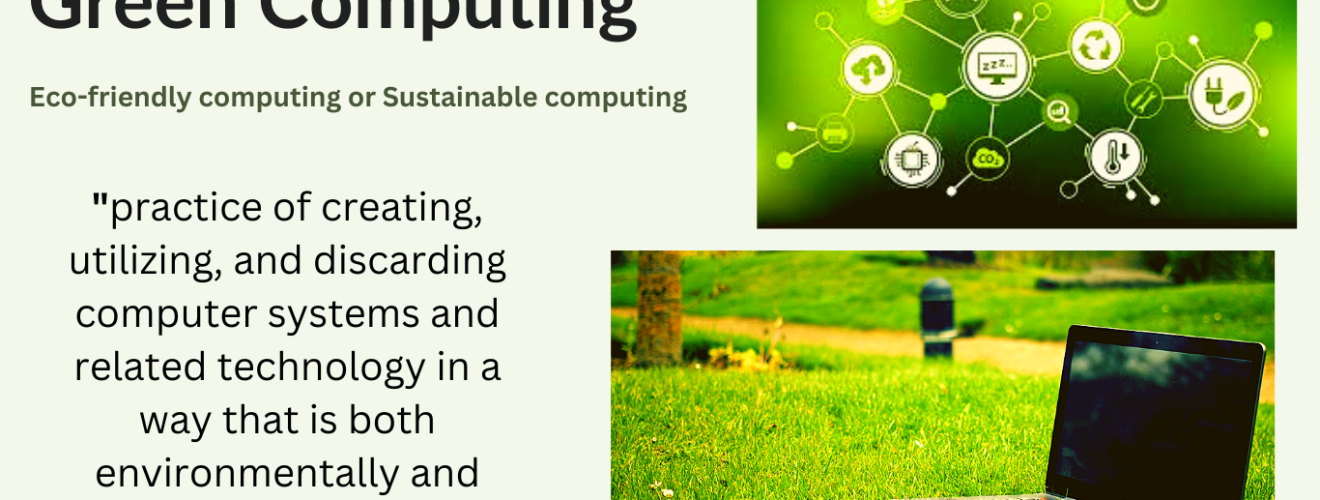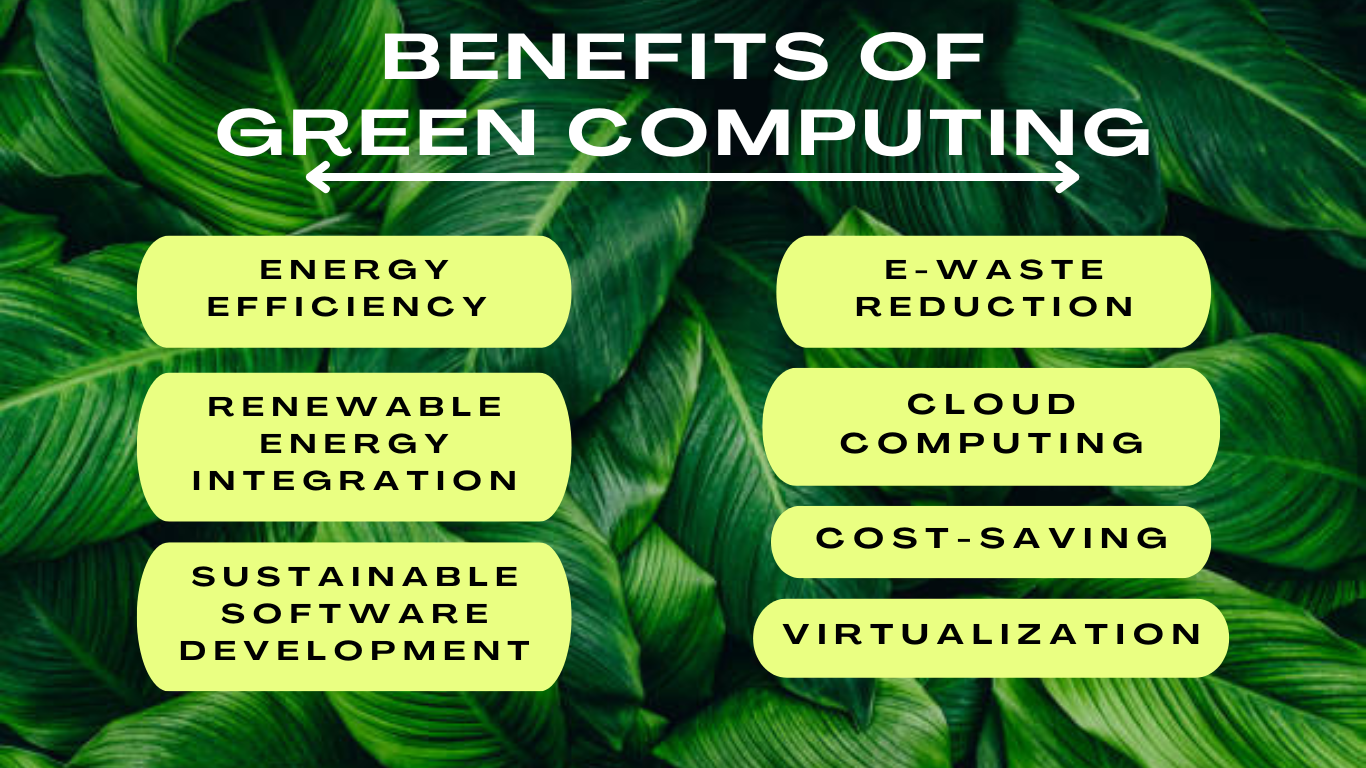Green Computing: Sustainable Technology for a Greener Future

Green computing is a revolutionary idea in the world of technology that merges state-of-the-art innovations with a strong sense of environmental consciousness. By integrating these principles into every stage of computer system development, the IT sector can significantly decrease its carbon emissions and contribute to a more sustainable world for all.
Definition of Green Computing
The practice of developing, utilizing, and discarding computer systems and related technologies in a way that is both environmentally and energy-conscious is known as “green computing,” sometimes known as eco-friendly computing or “sustainable computing.”
The basic objective of green computing is to maximize information technology’s positive benefits while minimizing its adverse effects on the environment.
Some of the essential components of green computing are low energy use, minimal electronic waste, promoting recycling, and adopting environmentally friendly production processes. The plan promotes the employment of techniques and tools that lessen the environmental impact of computing systems over the course of their useful lives.
Importance of Green Computing in Today’s World
It’s critical to take the environment into account as technology develops and the demand for computer resources rises. There are several urgent problems that need to be solved, including resource depletion, electronic trash accumulation, and global warming. Fortunately, by adopting green computing strategies, both people and organizations may contribute to the advancement of a sustainable and environmentally friendly future. Let’s work together to improve the world for future generations!
The Benefits of Green Computing

The Benefits of Green Computing
Energy Efficiency
Green Computing is all about making IT more energy efficient. By using power-efficient hardware components, optimizing data centers operations, and implementing energy management software, we can reduce energy consumption and lower greenhouse gas emissions. This will help create a more sustainable energy future for all of us.
E-Waste Reduction
With the rapid advancements in technology, it’s common to end up with a lot of electronic waste. However, there’s a solution! Green Computing recommends recycling and refurbishing old electronic devices. This not only lessens the amount of waste on our planet but also extends the lifespan of our gadgets. It’s a positive outcome for everyone involved!
Renewable Energy Integration
Green computing energy promotes the use of renewable energy sources in data centers and computing facilities to further promote sustainability. Converting to solar, wind, or hydroelectric energy can drastically lower the IT industry’s environmental impact.
Cost Savings
Did you know that using green computing practices can help both the environment and your wallet? For organizations and individuals, optimizing energy use and extending the lifespan of computing equipment can lead to significant cost savings and an eco-friendlier approach. So, it’s a win-win situation for everyone!
Virtualization
Are you aware of the benefits of virtualization? It’s a clever and environmentally-friendly solution to make the most out of your computing needs. By running multiple virtual machines on a single physical machine, you can consolidate your data centers and servers, while reducing energy consumption and hardware requirements. This not only saves you money but also promotes sustainability in your IT infrastructure.
Cloud Computing
Nowadays, businesses rely heavily on cloud computing to run their operations smoothly. Cloud services are a great way to optimize resource allocation and reduce the need for physical hardware. What’s more, cloud data centers are often eco-friendly and powered by renewable energy sources, which is a fantastic alternative to traditional data centers that consume a lot of energy.
Sustainable Software Development
As someone who cares deeply about the environment, I believe software developers hold an important role in promoting green computing. By crafting code that is both efficient and optimized, they can greatly reduce energy consumption. Moreover, it’s heart-warming to see developers creating applications that prioritize environmental impact, as this helps ensure that sustainable practices are promoted through their work.
Implementing Green Computing in Everyday Life
With a better understanding of the importance of Green Computing, we can take action in our daily lives to make a positive impact on the environment. Through small choices and adjustments, we can work together to create a more sustainable future. Let’s follow the key point:-
Opt for Energy-Efficient Devices
When you’re in the market for new computers, laptops, or electronic gadgets, consider purchasing energy-efficient models. Those with an Energy Star rating are designed to use less power, which will not only help you reduce your energy consumption but also contribute to a healthier planet. Also, don’t forget to turn off or put your devices in sleep mode when not in use, as this can save a significant amount of energy over time. Remember, every small step counts in showing love to our environment.
Recycle and Donate Electronics
Instead of throwing away your old electronics, why not consider recycling them? It’s easy to find local e-waste recycling centers where you can safely dispose of your old devices. And if your electronics are still in good working condition, you might even consider donating them to charitable organizations or schools in need. Not only will you help others in your community, but you’ll also be doing your part to create a more sustainable world by extending the life of your old devices.
Embrace Cloud Computing
Cloud computing is truly amazing when it comes to taking care of our planet. By utilizing cloud-based services, you can significantly reduce the need for on-site data centers and servers, which consume vast amounts of energy. Cloud providers are always looking for ways to optimize their infrastructure for efficiency, leading to a much smaller overall carbon footprint. Moreover, cloud services are incredibly flexible and can scale resources based on demand, which further enhances energy efficiency.
Go Paperless
In today’s digital age, let’s show our love for the environment by embracing electronic documents and communication. By opting for emails instead of physical printouts, and storing files electronically, we can reduce paper waste and help keep our planet healthy. Not only that, but it’ll also make our workspace more organized and less cluttered. Let’s spread the love and make the switch to digital!
Choose Green Web Hosting
If you’re the proud owner of a website or blog, why not consider opting for green web hosting services? These providers harness renewable energy sources to power their servers, making them a more caring and eco-conscious option. By choosing green web hosting, you can join the movement towards reducing the carbon footprint of the internet and support sustainable practices in the digital world. It’s a small way to show some love to our planet and make a positive difference!
Educate and Raise Awareness
Why not share the love of Green Computing and its importance with your loved ones, friends, and colleagues? Encourage them to embrace eco-friendly habits in their tech usage and spread the word about the benefits of sustainable IT. When more people know about these practices, we can all contribute to creating a more loving and greener future together.
Popular Contents: Biotechnology: A Promising Solution to Environmental Pollution Eco-Friendly Travel Practices: Tips for a Sustainable Journey Solar Energy: Benefits and Negative Sides
The Future of Green Computing: Innovations and Trends
The field of Green Computing is constantly transforming and presenting new advancements and trends that have the potential to bring about a sustainable future. It’s an exciting time as we witness the evolution of eco-friendly technology and its impact on our environment. Let’s take a closer look at some of these developments that promise to revolutionize the way we interact with technology and the world around us. Let’s check some key points:-
Energy Harvesting Technologies
The field of Green Computing is making progress thanks to energy-harvesting technology. This technology harnesses ambient energy to power electronic devices, reducing our dependence on traditional energy sources.
Biodegradable Electronics
Indeed, electronic devices can often become hazardous e-waste, which can contribute to environmental pollution. However, there is a positive development in the field of electronics: researchers and manufacturers are now exploring the use of biodegradable materials to build devices that will naturally break down over time. This means that we can look forward to a more sustainable future, where we can minimize the impact of electronic waste on the environment. It’s exciting to see the possibilities that biodegradable electronics can offer, and we can all play a part in making this future a reality.
Virtualization and Resource Optimization
To make data centers efficient, it is important to use virtualization and optimize resources. One way to do this is by consolidating virtual machines on a single physical server. This reduces hardware requirements, leading to a significant decrease in energy consumption and operational costs. Additionally, advanced resource allocation algorithms ensure that computing resources are utilized optimally, resulting in even greater energy efficiency.
Internet of Things (IoT) for Sustainability
The Internet of Things (IoT) is a valuable tool for promoting sustainable practices. With IoT, we can connect and monitor our homes, offices, and industries in ways that were not possible before. Smart thermostats, lighting systems, and automated energy management systems allow us to optimize energy usage and reduce waste, contributing to a more sustainable way of living.
Eco-Friendly Data Centers
The data center industry is shifting towards environmental friendliness. These centers, which house powerful technology, previously consumed large amounts of energy. However, they are now emphasizing sustainability and eco-friendliness. By implementing renewable energy sources, advanced cooling methods, and energy-efficient hardware, they are taking steps to reduce their impact on the environment.
Green Software Development
It’s heartening to witness the technology industry moving towards more eco-friendly programming as it evolves. Programmers are now focusing on creating energy-efficient software that requires fewer resources. This has resulted in more efficient coding practices and optimized algorithms to reduce energy consumption. The software industry’s shift towards a greener approach to development is a delightful sight.
Carbon Footprint Tracking Tools
Looking for ways to reduce your environmental impact? Carbon footprint tracking tools are here to help! By monitoring your energy usage, transportation, and daily activities, these tools can help you better understand your carbon emissions. Armed with this knowledge, you can make informed decisions to reduce your carbon footprint and show some love to our planet.
In conclusion, it’s important to embrace the practice of green computing with love and compassion. The world is facing many environmental challenges, and rapidly advancing technology is exacerbating the problem. By adopting eco-friendly practices in the IT industry, we can help mitigate the impact on our planet and show our love for it.
Green computing emphasizes energy efficiency, responsible e-waste management, and sustainable IT practices, all of which contribute to a more loving and caring future.
As individuals, businesses, and governments, we have a collective responsibility to integrate green computing principles into our daily operations with love and kindness. This will help us reduce carbon emissions, conserve valuable resources, and contribute to global efforts to combat climate change and environmental degradation, all while showing our love for the world we live in.







